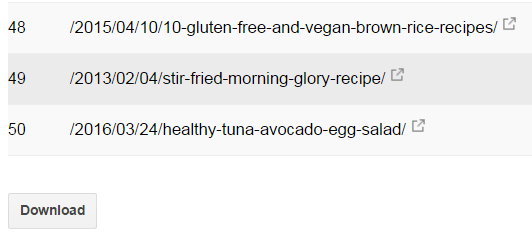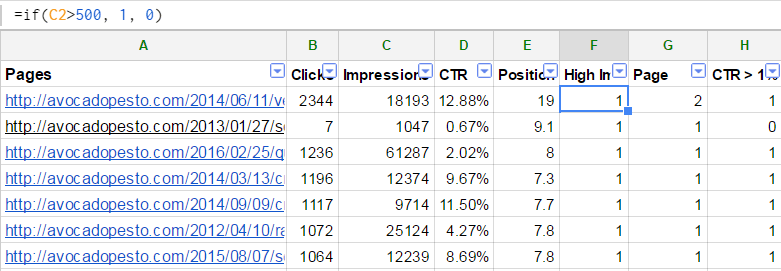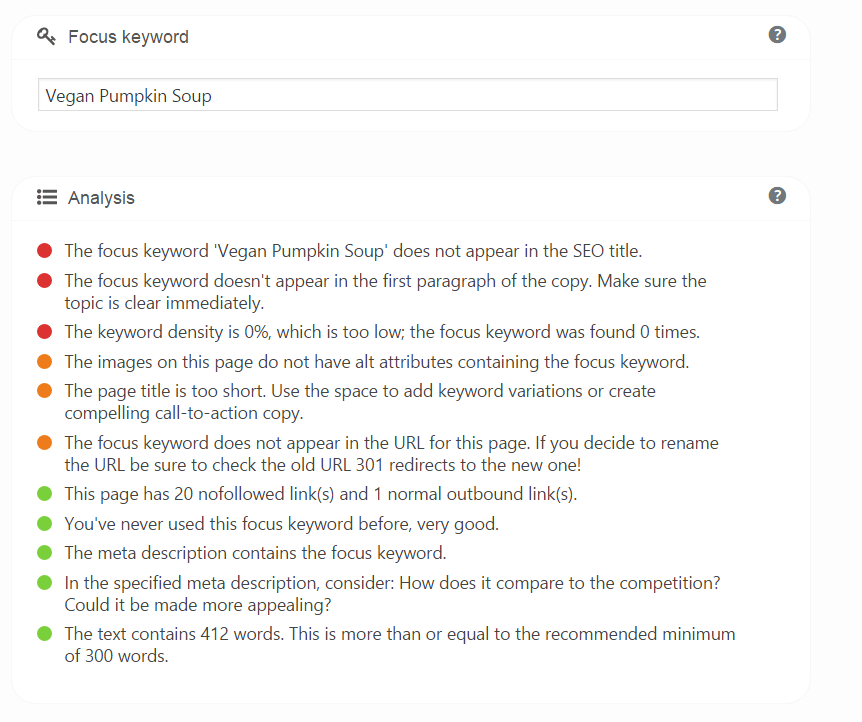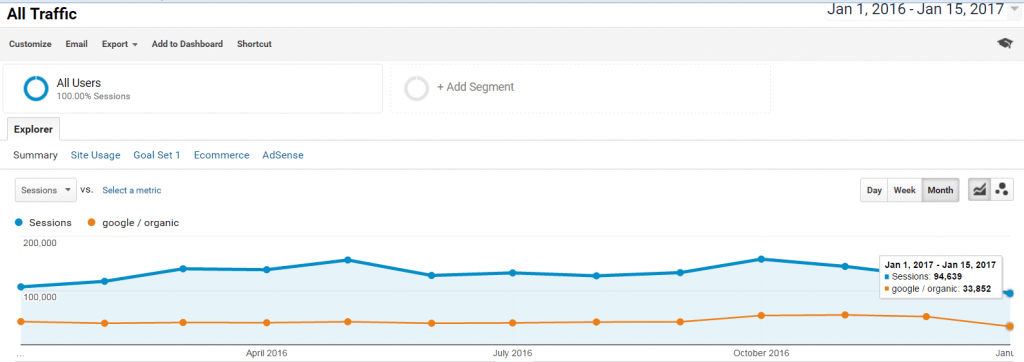Many people overlook the value of optimizing existing blog posts. As the classic adage says, out with the old and in with the new, right?
In reality, old posts are arguably the best to optimize.
It’s because you have the added benefit of 20/20 hindsight. Since the content is already there, you can now identify which posts have the strongest chances of ranking in the top 5 on search engines.
Not only that, but you can check which keywords existing posts are already ranking for – creating an ideal 80/20 approach to post optimization.
In many cases, websites have hundreds of existing blog posts in limbo – some of which have the potential to really shine with a few tweaks.
Since you’ve already made the investment to create a blog post, why not refine it so it starts generating a stronger return for you?
Of course, I won’t ask you to just take my word for it. So in this article, I’ll present my own case study about how I executed this methodology AND increased organic traffic by over 40%.
In this extensive guide, I’ll cover the following:
- The benefits of updating old content
- How often to update older posts
- How to discover which posts to optimize
- How to determine which keywords to target
- How to optimize the post for these keywords
- Tips for making old blog posts stand out
Afterwards, I’ll show you what effect this had overall on the website.
Let’s dive in.
What Can Updating Older Blog Posts Do For You?
Are you still on the fence about updating your old content? If so, perhaps these attractive benefits will help you see the light. Updated blogs can generate organic traffic and reignite interest in older topics, among many other things.
Acquire Outdated Competitor Backlinks
It’s crucial to regularly update content to obtain (and retain) quality backlinks. Let’s say that you have an article on your website entitled ‘FinTech Trends for 2021’ that you haven’t updated yet.
From there, you notice a key competitor with attractive backlinks that hasn’t updated their FinTech trends article either. You jump at the opportunity and become the first to post ‘FinTech Trends for 2022.’
Next, you reach out to the backlink owners from the competitors’ article and convince them to link to your more current post instead. That’s a decision they’re likely to make since nobody wants to link to outdated content. To discover which backlinks your competitors have, you can use a backlink checker tool like the one from Ahrefs.
That’s how you can use updated blog posts to acquire competitor backlinks. Also, updating your content will help you retain the backlinks you fought so hard to get. So remember – do your absolute best to keep your blog posts updated for the sake of your domain authority.
Obtain Thought Leader Status Among Readers
It should be the goal of any content marketing strategy to build loyalty among readers. One of the most reliable ways is to keep your posts updated. It doesn’t bode well for your blog whenever users land on outdated content – and it’s also a guarantee that they’ll look for updated information elsewhere.
If your blogs get updated regularly, the opposite will take place. Readers will know that they can always expect the most valuable, up-to-date information from your blogs.
That’s a fantastic way to obtain ‘thought leader’ status – something that every blog attempts to do but few perfect.
Updating your existing content is a must if you want readers to flock to your blog. It shows that you care about your content and want to provide the maximum amount of value to your readers. If you’re struggling to retain readers on your blog, try updating your posts and creating evergreen content (blogs that remain fresh over time and answer questions that don’t change.)
Stay Current with the Latest SEO Tactics
SEO strategies are constantly changing and evolving, so updating your content is essential. What worked for SEO in 2018 will see drastically different results in 2022.
Whenever you update a blog post, make sure to include the SEO best practices of the current era.
An example would be incorporating keyword clustering into an old article that only focused on a single keyword. A keyword cluster is a group of related keywords with the same purchase intent. It’s a more recent strategy that can provide impressive results and is now preferred over only using a few keywords.
Conversely, some older strategies can even land you in hot water with Google and other search engines. Back in the 2010s, keyword stuffing or spamming was a widespread practice – which is now frowned upon and penalized today.
If you’ve got a ton of old blog posts from 2011 – it’s wise to dig them up and look at what they have going on. You never know; you may discover an older blog perfect for today’s age with just a few adjustments.
Generate More Revenue From an Existing Investment
Last but not least, updating existing content will help you capitalize on the money you’ve already spent.
It would be a shame to let content you spent money on disappear into obscurity forever.
Instead, you can keep generating revenue from content you’ve already spent money on by simply updating it. I’ve found that tweaks like adding the current year, doing new keyword research, and adding more insights can drive lots of new traffic to a once-dead blog post.
Much like SEO itself, blog posts can continue working for you well into the future. As long as you keep updating them and adding relevant new information, a single blog post can generate traffic for many years.
So if you’re a fan of getting the most bang for your buck, updating your older blogs should be a no-brainer.
Remember, you’ve already spent the money, so why not do everything you can to get that money back and then some?
It’s a plus for you as you get to conjure new interest in an existing piece. It’s also a win for your readers as they enjoy new insights and up-to-date information by reading the post. In short, updating older blog posts provides a lot of perks with next to no downsides – and it’s a great way to generate new traffic and revenue.
How Often Should You Update Old Content?
There are several ways to go about this, but I like using free tools like Google Search Console.
So first, go to Google Search Console. Below it, click Search Traffic > Search Analytics.

Google Search Console
Make sure the boxes for Clicks, Impressions, CTR, and Position are all checked. These are the metrics that you’ll want to view for each blog post.

Search Console Filters
Search Console Filters
There are numerous ways to filter the search results on Google Search Console – so it’s imperative to know which one to use to find blog posts in need of updating. A quick and reliable way to use the Pages filter. It’s my preferred filter because it’s the simplest way to view the performance statistics of a particular page.
That way, you can determine if the blog in question is worth updating or not by viewing its CTR, impressions, and position. Ideally, you want to update blogs that currently aren’t doing very well, but are within range of obtaining traffic.
A potential drawback of the Pages filter is that you can only view one page at a time.
If you need to view the performance of an entire category of pages (such as all blog posts or a sub-category), you’ll need to use the URL containing filter. I sometimes use it to see if several older posts need updating.
The filter contains other valuable information, such as how Google viewed your site when crawling it. Data points include when Google crawled your page and any navigational mistakes during indexing.
That comes in handy for pinpointing technical issues holding your posts back in the search rankings.
Once you’ve selected the appropriate filter, you’ll want to download the results and place them in a spreadsheet for analysis.

Download Search Console
Download Search Console Results
At this point, you have two options.
- Option 1: Optimize all the posts (skip the following section)
- Option 2: Focus only on the posts that will give you the largest gains
If you have a smaller blog with only a handful of posts, option 1 might be the best.
But, if you’re like most people and want to work at peak efficiency, I’m going to give you some highly adjustable criteria that you can use to identify the posts that will give you the most bang for your buck.
That criteria is:
- A CTR lower than 1%
- A ‘high’ impression rate (what you consider high depends on your blog / it’s traffic)
- A position between 1 to 30
I chose this criteria because it tells me that the post is ranking for something that has volume, is being seen, but for some reason isn’t getting clicked enough.
In theory, if we can move it up in the rankings and optimize the title / description to be more relevant to what the user is searching for, we can generate more clicks.
Given that, create three columns used specifically for the criteria, and use IF statements to indicate whether or not the post is getting high impressions, how it’s ranking, and if the click through rate is lower than 1%.

OnPage SEO Stats
On-Page SEO Stats
You can then filter out the posts that don’t fit the criteria to avoid updating content that won’t lead to conversions or generate organic traffic. As stated before, I only recommend updating every post if you just have a handful.
If your blog has been going strong for years now, optimizing every post will take a lot of time and effort – and won’t necessarily lead to any returns.
That’s why I highly suggest only optimizing posts that meet your criteria. Bear in mind that you can adjust and tweak my provided criteria as much as necessary for your needs. That’s especially true for the impression rate, as it will vary greatly depending on your blog and the average amount of traffic you see.
It’s best to have a clear reason to update content instead of just going through the motions. An example would be a revitalized interest in a topic you covered in the past.
Let’s say, years ago, you did a piece on digital marketing trends that weren’t prevalent at the time but have since sparked in popularity. That’s a great reason to revisit the post and beef it up with fresh content and new insights. Since you know there’s interest in the topic; it stands a greater chance of attracting interest.
How To Determine Which Keywords You Should Be Targeting
You now have your target posts, so let’s find out what keywords you should target for maximum effectiveness.
Venture back to Google Search Console to the same screen with your chosen filter and find a post that you want to optimize. Note – you may have to go to the bottom and increase the number of results to show more if you don’t see the blog you want to update.
Click the post, and then adjust the filter from Pages to Queries.

Search Console Queries
Search Console Queries
Now it’s time to learn about another filter you can use on Google Search Console, Queries. This query provides an invaluable report containing vital keyword information about your website. In particular, you’ll get to discover all the keywords you’re currently showing up for on Google’s search engine results pages.
Beyond that, you also get to see which keywords are actively driving users to visit your website. That lets you know which keywords are the most valuable for each webpage, which is incredibly useful.
It helps you avoid placing focus on keywords that you don’t stand a chance at ranking for and lets you know where you’re currently finding the most success.
You can also view the information by date range, which is especially helpful for updating older posts. I like to set the range to cover the last three to four months, giving me full visibility of the entire business quarter.
You can sort the results to show pages with low CTR yet high ranking and strong impressions. That’s a sure-fire way to locate pages with high-quality keywords that aren’t getting the clicks they deserve. From there, you can go about tweaking the pages to obtain a boost in traffic once the click-through-rate improves.
Another favorite technique of mine is to sort by impressions, so the keyword queries receiving the most impressions are at the top.

Sort By Impressions
Sort By Impressions
Generally, the top one is what I choose to make the focus keyword unless I find that it’s totally irrelevant. The other ones can serve as great secondary keywords for even more of a boost. I create two more columns in the spreadsheet for my focus keywords and go through all the posts in the list.
You can also filter the results to only show posts with impressions of 1,000 or greater (or another number of your choosing.)
That way, you’ll only view keywords generating the most interest. Remember, a post containing a valuable keyword isn’t enough. The post must have valuable, well-written content that outdoes the competition.
Keywords are undoubtedly necessary to succeed with SEO, but they go hand-in-hand with creating stand-out content. You’ll want to create posts that inform, educate, entertain, and ultimately convert readers into customers.
How To Optimize The Post For These Keywords
Once you’ve built your list of blog posts that are ripe for optimization, you’re all set to get started on the actual process of updating them.
I highly recommend Yoast’s WordPress plugin as it’s one of the most helpful SEO tools on the market. It also has a Focus Keyword feature where you can enter your target keyword, and it spits out recommendations.

Yoast SEO WordPress Plugin
Yoast SEO WordPress Plugin
Yoast works by providing you with an ‘SEO score’ for each one of your blog posts and web pages. Your score will be a series of color-coded circles grading each aspect of your content in regards to how optimized it is for search engines. Here’s a rundown of Yoast’s color-coding system:
- Gray: If you see a gray circle, that means there isn’t enough information on the page to calculate an SEO score.
- Red: This represents the weakest SEO score and signifies that your post needs improvement.
- Orange: This isn’t the worst but it is still a poor SEO score that needs work.
- Yellow: If you see a yellow circle, the SEO score is average but still isn’t great yet.
- Green: If you’ve got a green circle, you have a high SEO score, and your content is optimized well.
If your Yoast SEO score is red or orange, the post needs some serious work. To make things easier, Yoast separates the tasks it scores you on into three categories:
- Problems. Under this category, Yoast will list all your red circles. These are the most troublesome areas that you should focus on first. Examples of a red circle include missing a meta description or title, broken links, and having a keyword density of 0%.
- Improvements. This category contains all your orange circles – which are weak areas that need improving. Examples include missing alt tags and not including your target keyword in a header.
- Good Results. Here, you’ll find all your green circles or the areas where you’re doing the best. Ideally, you want to make as many circles go green as you can – or at least yellow.
You’re doing things right when you don’t see any orange or red circles. That means your content is highly optimized and stands a great chance of generating website traffic.
The plugin updates in real-time, so it’s quite easy to follow your progress. It’s free, but the premium version allows you to add additional keywords and contains other robust features. Besides scoring your SEO overall, Yoast’s Focus Keyword feature makes it effortless to build an extensive list of keywords related to your niche.
General Tips for Optimizing and Improving Blog Posts
Beyond using Yoast’s plugin, there are some sure-fire ways to improve a post, such as:
Add Images with Alt-Text
Want to know a great way to strengthen any post and potentially outdo the competition? Include high-resolution images and visuals that are relevant to your post. Once again, the idea is to add images that are RELEVANT to your post. Stock images are totally fine, but you need to make sure that they relate to what you’re talking about and aren’t totally random.
I always make a point to include images in my posts because they’re excellent for breaking up the monotony of continuous text. Also, relevant images can work to enhance readers’ understanding of the subject matter. Beyond stock images and original photos, infographics are amazing for SEO. That’s because they not only provide a visual but also entertain and embellish the topic.
Also, every image you upload needs alt text or an alt description.
What’s that?
Alt-text is a physical description of what an image contains. It has three primary uses, the first of which is for accessibility. Anyone that’s visually impaired will have a text-to-speech program read the alt description to them so they can understand the image.
Next, and this is why it’s crucial for SEO, is it provides image context for search engine crawlers. In other words, it helps engines like Google to index your images properly.
Lastly, the alt text is what will display if the image fails to load.
To ensure search engines understand your images and what they represent, always include an alt description for the visuals on your posts.
Fix Grammar and Formatting Issues
You aren’t doing yourself any favors if your content and headings contain spelling and grammatical errors. First and foremost, these errors affect readers the most. Nothing will hurt your trust and reader loyalty more than constant formatting and grammatical errors. It reflects poorly on your brand because you didn’t care enough to make sure your posts were readable.
If you want readers to take you seriously, aim only to publish (or republish) flawless content containing no errors.
There are plenty of tools that can help you do this, such as Grammarly, which has a totally free version you can use. The premium version takes things a step further by assisting with things like sentence structure and enhancing vocabulary.
While it’s critical to have impeccable grammar and formatting for readers, it also matters to search engines too. In particular, Bing programmed their algorithm to only rank content that contains no errors whatsoever. That’s another reason why double and triple-checking grammar, spelling, and style is crucial for your blog posts.
Add More Internal Links, Research-Backed Stats, and New Backlinks
External links to reputable websites will boost your domain authority. Also, internal links are great for your SEO and also create a web of interrelated content on your site. Well-placed internal links can also influence readers to check out your other posts – driving more traffic to them in turn.
Research-backed stats will also boost your authority in the eyes of search engines. If you make a claim, do your best to back it up with a study or report from a trusted source. Try to find links from .gov, .edu, and .org websites in particular.
Also, you’ll want to add new backlinks to any articles that you update. More recent, high-authority backlinks will work wonders for your domain authority. As I stated before, updating old blogs is a reliable way to poach links from other outdated posts by competitors.
Lastly, take a look at your cited sources. The chances are high that they’ll be just as outdated as your blog post. Replacing them with updated citations is another way to optimize an aging post.
Use More Multimedia Content for the Post
I already mentioned how effective infographics are at enhancing articles. Yet, they aren’t the only form of multimedia that will add value to your blogs. There are also videos, slide decks, GIFs, tables, podcast episodes, and more. These are all fantastic additions to a post so long as they’re relevant and provide additional insights.
An example would be including a how-to YouTube video embedded in one of your posts. Ideally, the video should contain original content separate from the blog post.
You never want media to replace your written content, only to enhance it and serve alongside it.
Let’s say you have a post going over the health benefits of spinach. As a companion to the article, you include a YouTube video containing a tasty recipe for a spinach salad. The video doesn’t step on the article’s toes – but instead serves to enhance it by providing a recipe readers can make once they realize how healthy spinach is for them.
The Results
Between August and December of 2016, I used exactly this method to optimize nearly 200 old posts on AvocadoPesto, my girlfriend’s food blog.
Mind you, we did very little in the ways of adding new content, rewriting, or adding images. The primary focus was simply keyword adjustment and following Yoast’s guidelines. On average, optimizing each post took about 10 minutes, so in total the project took around 30 hours.
Here are the results.

Onpage SEO Results
On-Page SEO Results
As you can see, for a long time the blog’s organic traffic was stagnant at around 40k organic visitors a month, even though new content was being produced weekly!
In September, after we started optimizing, there was a noticeable uptick to 55k visitors; an increase of almost 40%!
January, being only half over, is on track to surpass 60k visitors, which would be a 50% increase overall.
Not bad for less than a week’s worth of work.
Concluding Thoughts: How to Re-Optimize Your Old Blog Posts To Boost Traffic
Now that you know my step-by-step blog revitalization process, it’s time to take your old (or dead) content out for a makeover. That way, you can derive more value out of your existing content and start ranking higher in users’ organic search queries.
What I’ve shown you is not something overly technical or complicated and honestly can be accomplished with the help of a dedicated assistant. It’s a paint-by-the-numbers process that’s pretty easy to do once you get the hang of it – and it’s well worth the payoff.
If you have anything to add or share about your experience optimizing existing posts, let us know about it in the comments below.



